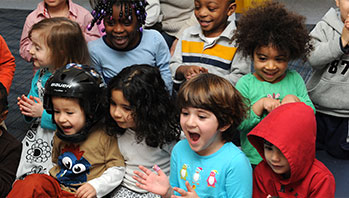MA Standards:
Speaking and Listening/
SL.PK.MA.1a: Observe and use appropriate ways of interacting in a group (e.g., taking turns in talking, listening to peers, waiting to speak until another person is finished talking, asking questions and waiting for an answer, gaining the floor in appropriate ways).
Foundational Skills/
RF.PK.MA.3.c: Recognize one’s own name and familiar common signs and labels (e.g., STOP).
Head Start Outcomes:
Social Emotional Development/
Self-Regulation: Follows simple rules, routines, and directions.
Language Development/Receptive Language: Attends to language during conversations, songs, stories, or other learning experiences.
PreK Learning Guidelines:
English Language Arts/Language 1: Observe and use appropriate ways of interacting in a group (taking turns in talking; listening to peers; waiting until someone is finished; asking questions and waiting for an answer; gaining the floor in appropriate ways).
English Language Arts/Reading and Literature 12: Listen to, recite, sing, and dramatize a variety of age-appropriate literature.
Greeting Song: “Good Morning” #1

© Commonwealth of Massachusetts, Department of Early Education and Care (Jennifer Waddell photographer). All rights reserved.
ELA Focus Skills: Name Recognition, Phonological Awareness
Have children sit together in a circle and sing “Good Morning” to each child. Explain to children that as you sing the third line, you will signal to a child and you want that child to say his or her name out loud.
Sing the song to the child, and then ask everyone to repeat the his or her name in the cheer, Hooray <child’s name>! You’re here today! Continue around the circle and repeat the process until each child has been acknowledged.
Good Morning
(sung to the tune of “Happy Birthday”)
Good morning to you,
Good morning to you,
Good morning dear <child’s name>,
We’re glad you are here.
Together we’ll play.
Together we’ll learn,
And together we sing this
So your friends can all cheer!
(cheer)
Hooray <child's name!> You're here today!
Social Emotional Tip: Having everyone acknowledge that they are part of the group helps to build that child’s self-confidence and sense of belonging.
Take It Further: As children repeat each name, have them join you in clapping out the name parts. Demonstrate how names have different numbers of parts by clapping out a one syllable name, a two-syllable name, etc.
